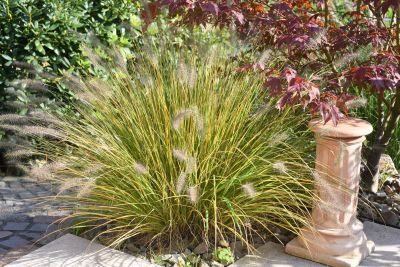Fountain grass is an attractive perennial grass with densely clumped growth. Blooming of its foxtail-looking flowers generally takes place from late summer through the fall. The small flowers of fountain grass are tan, pink or purple. During fall and throughout winter, this plant will also reward gardeners with spectacular foliage displays.
Types of Fountain Grass
There are different types of fountain grass to choose, ranging in size from 12 inches to 3 feet (30 to 90 cm.). One of the most common varieties is dwarf fountain grass Hameln (P. alopecuroides ‘Hameln’). Its light tan blooms turn pinkish brown in fall. This fountain grass blooms earlier than the others, making it a great choice for gardens with shorter growing seasons. Purple fountain grass (P. setaceum) has both purple foliage and blooms. Used for its reddish foliage and showy flowers is red fountain grass (P. setaceum ‘Rubrum’), which grows about 3 to 4 feet (0.9 to 1.2 m.) tall. Other types of fountain grass cultivars include ‘Cassian,’ ‘Little Bunny’, ‘Little Honey’, and ‘Moudry’.
Growing Fountain Grass
Growing fountain grass is easy. As with most ornamental grasses, fountain grass is extremely adaptable. Care of fountain grass is easy as well. It’s sometimes helpful to cut back the foliage in the spring prior to growth. Although not specifically a requirement for fountain grass, fertilizer can be applied as growth resumes in the spring. Established plants do not need regular watering, except during periods of drought. Fountain grass does well in nearly any type of soil; however, for greater results, fountain grass should be planted in fertile, well-drained soil. Fountain grass enjoys full sun but tolerates some light shade. Look for areas receiving full sun, as these plants prefer warm conditions. Warm-season grasses thrive in warmer temperatures ranging from 75 to 85 F. (24-29 C.).
Transplanting Fountain Grass
Transplanting fountain grass is not always necessary; however, it can be dug up and divided in areas where overcrowding may occur or if more plants are simply desired. Division usually depends on spacing or visual appearance. For instance, plants suffering from die-out in the center can be divided to improve their appearance. Division can be performed in early spring prior to new growth or after the growing season in the late summer or fall. Taking care of fountain grass is a rewarding undertaking for a gardener. By growing fountain grass, you add a low maintenance option to your garden.
